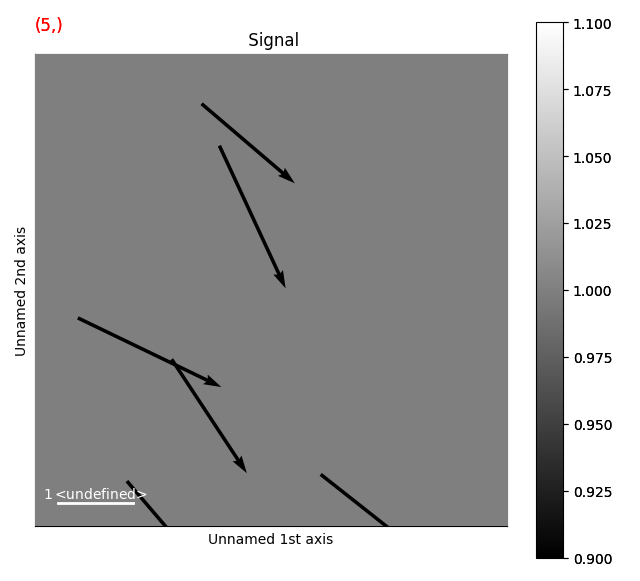Note
Go to the end to download the full example code.
Varying number of arrows per navigation position#
Create a signal
import hyperspy.api as hs
import numpy as np
# Create a Signal2D with 2 navigation dimensions
rng = np.random.default_rng(0)
data = np.ones((10, 100, 100))
s = hs.signals.Signal2D(data)
for axis in s.axes_manager.signal_axes:
axis.scale = 2*np.pi / 100
# Select navigation position 5
s.axes_manager.indices = (5, )
Dynamic Arrow Markers: Changing Length#
This example shows how to use the Arrows marker with a varying number of arrows per navigation position
# Define the position of the arrows, use ragged array to enable the navigation
# position dependence
offsets= np.empty(s.axes_manager.navigation_shape, dtype=object)
U = np.empty(s.axes_manager.navigation_shape, dtype=object)
V = np.empty(s.axes_manager.navigation_shape, dtype=object)
for ind in np.ndindex(U.shape):
offsets[ind] = rng.random((ind[0]+1, 2)) * 6
U[ind] = rng.random(ind[0]+1) * 2
V[ind] = rng.random(ind[0]+1) * 2
m = hs.plot.markers.Arrows(
offsets,
U,
V,
)
s.plot()
s.add_marker(m)
/opt/hostedtoolcache/Python/3.12.12/x64/lib/python3.12/site-packages/rsciio/utils/rgb_tools.py:62: VisibleDeprecationWarning: The module `rsciio.utils.rgb_tools` has been renamed to `rsciio.utils.rgb` and it will be removed in version 1.0.
warnings.warn(
/opt/hostedtoolcache/Python/3.12.12/x64/lib/python3.12/site-packages/rsciio/utils/rgb_tools.py:62: VisibleDeprecationWarning: The module `rsciio.utils.rgb_tools` has been renamed to `rsciio.utils.rgb` and it will be removed in version 1.0.
warnings.warn(
sphinx_gallery_thumbnail_number = 2
Total running time of the script: (0 minutes 0.769 seconds)


